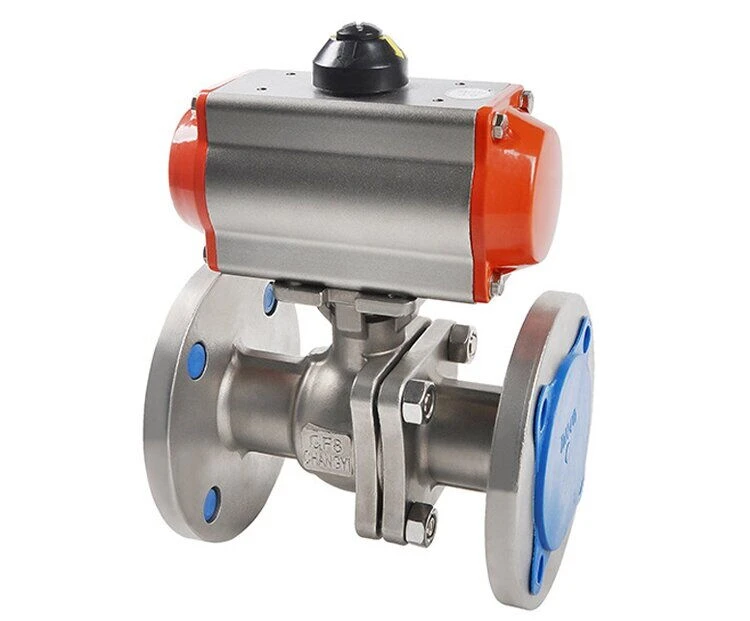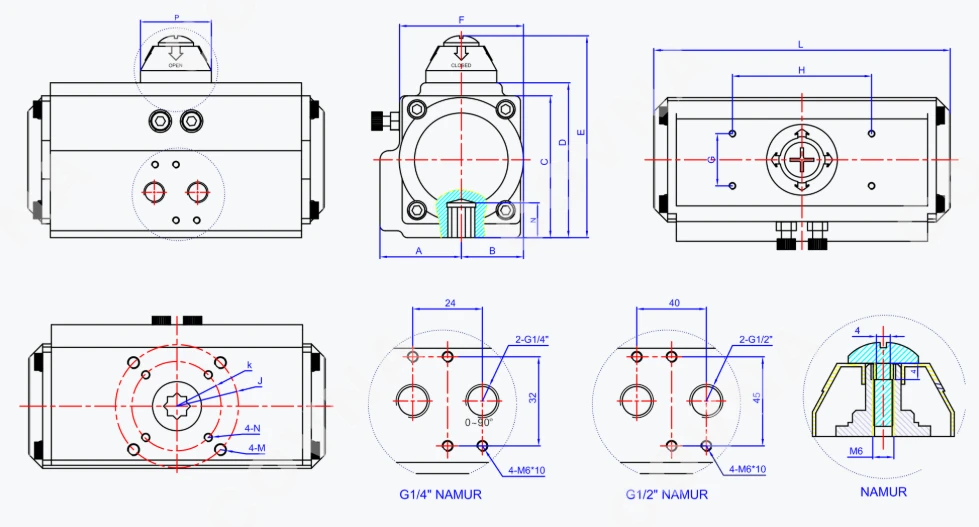Pneumatic Flange Ball Valves: Reliable Solutions for Modern Flow Control
Introduction
In today’s demanding industrial environments, precise and reliable flow control is essential for maintaining safe, efficient, and cost-effective operations. Pneumatic flange ball valves have emerged as a trusted solution for on-off control of a wide range of fluids — including water, air, oil, and other compatible media — across various industries.
These valves, when paired with pneumatic actuators, offer fast and dependable operation. For example, spring-return (single-acting) actuators use a pneumatic pilot signal to move the valve to the desired position, and built-in springs automatically return the valve to its default fail-safe position in the event of air loss. Double-acting actuators, on the other hand, rely on air pressure for both opening and closing actions, providing responsive and repeatable performance.
Compared to other valve types, air-actuated ball valves deliver unique advantages, such as higher flow capacities, suitability for high-pressure and high-temperature applications, broad media compatibility, reduced water hammer, and safe use in hazardous environments due to the absence of electrical ignition risks.

What Are Pneumatic Flange Ball Valves?
At their core, pneumatic flange ball valves combine two key components: a robust, flange-connected ball valve and a pneumatic actuator. Compressed air enters the actuator, driving the internal mechanism that rotates the ball. This quarter-turn rotation — typically 90 degrees — enables precise opening and closing of the valve to start or stop flow instantly.
The flanged ends make installation and maintenance straightforward, especially in larger pipelines or systems requiring frequent disassembly and reassembly. The flanges provide strong, leak-tight connections that can handle high pressures and aggressive media without compromise.
Key Benefits of Pneumatic Flange Ball Valves
Pneumatic flange ball valves deliver a range of operational and practical benefits that make them a preferred choice for engineers and facility operators alike:
Minimal Flow Resistance
The straight-through flow path of a ball valve results in minimal fluid resistance — the resistance coefficient is comparable to that of an equally sized length of pipe. This design helps maintain steady flow rates and minimizes energy losses in the system.
Compact and Lightweight Design
With a relatively simple internal structure and few moving parts, these valves are compact and lighter than many comparable control valves, making them easier to handle, install, and integrate into existing piping systems.
Excellent Sealing Performance
High-quality sealing materials — including various engineered plastics — ensure tight and reliable shutoff, even in vacuum applications. This makes pneumatic ball valves highly effective for isolating fluids and preventing leaks.
Fast Operation and Remote Control
The quarter-turn action means these valves open and close quickly. Combined with the use of pneumatic actuators, this enables remote operation for automated process control, boosting safety and efficiency.
Low Maintenance Requirements
Their simple structure makes maintenance straightforward. The movable sealing rings are easy to inspect and replace, minimizing downtime during routine servicing.
Media Isolation
When fully open or closed, the ball and seat sealing surfaces are fully isolated from the flow medium, reducing erosion and extending the valve’s service life.
Wide Range of Applications
From small pipelines to large-diameter systems — with bore sizes ranging from a few millimeters up to several meters — pneumatic flange ball valves handle everything from high vacuum to high-pressure conditions.

Typical Applications Across Industries
The versatility of pneumatic flange ball valves allows them to serve in a diverse range of industrial applications, including:
Chemical and Petrochemical Plants: For safe and precise control of aggressive or hazardous fluids.
Oil and Gas Pipelines: Ensuring reliable shutoff and flow isolation in critical systems.
Power Generation: Managing steam, condensate, and cooling water flows in power plants.
Metallurgy and Mining: Controlling slurry, water, or gas flows under challenging conditions.
Water and Wastewater Treatment: Automating flow paths in filtration, sedimentation, or discharge processes.
HVAC and Building Services: Regulating chilled water, hot water, or air supply.
Food and Beverage Processing: Ensuring sanitary flow control in clean-in-place (CIP) systems.
Additionally, they play a key role in automated process systems, where remote actuation and fail-safe operation are critical for both safety and efficiency.
How to Choose the Right Pneumatic Flange Ball Valve
Selecting the right pneumatic flange ball valve is vital to achieving reliable performance and longevity. Here are some practical guidelines:
Evaluate the specific working environment. Consider factors like ambient and process temperatures, working pressures, and the chemical properties of the media. For example, corrosive fluids may require special materials for the valve body and seats to ensure durability.
Determine the required flow capacity to size the valve correctly. The valve’s internal bore and design should match your system’s flow requirements to avoid underperformance or excess pressure drop.
Check that the valve provides excellent sealing performance for your application — especially if the process involves high pressures, high temperatures, or vacuum conditions. The actuator’s reliability is equally critical: ensure that the actuator can deliver sufficient torque for the valve’s full range of motion under all conditions.
Understand Actuator Requirements
Choose between single-acting (spring return) and double-acting actuators based on your fail-safe requirements and system design. Single-acting actuators automatically return the valve to a default position if air supply fails, which is ideal for emergency shutoff scenarios.
Look for valves with user-friendly designs that allow for easy inspection, seal replacement, and actuator servicing without removing the valve from the line.
Always review detailed product datasheets, pressure-temperature ratings, and material certifications to ensure the selected valve complies with relevant industry standards.
A Smart Investment in Efficiency and Safety
As industries continue to advance toward smarter, more automated systems, pneumatic flange ball valves remain a practical and cost-effective choice. Their combination of robust construction, fast actuation, tight shutoff, and minimal flow resistance makes them ideal for demanding applications where safety, reliability, and efficiency are paramount.
By carefully assessing your operating conditions, media requirements, and automation needs, you can select the ideal pneumatic flange ball valve to optimize your system’s performance — whether for simple on-off service or more complex automated process control.
Conclusion
In Summary, pneumatic flange ball valves offer a reliable and versatile solution for modern flow control challenges. From the smallest pipeline to the largest industrial network, they help operators achieve precise, automated control while minimizing downtime and maintenance costs — keeping your operations flowing smoothly and safely, every step of the way.
Send your message to this supplier
- https://www.cncontrol.cn/
- Address: Yongjia, Wenzhou, Zhejiang, P. R. China
- Phone: 86 577
- Business Type: Industry & Trading, Manufacturer,
Supplier Website
Source: https://www.controlvalve.net/news/pneumatic-flange-ball-valves-reliable-solutions-for-modern-flow-control.html

